Driven: The 2025 Aston Martin DBX707 Is More Lux and Limber
The Aston Martin DBX707 could be very easy to dislike, as least in concept. Cynically speaking, it’s an SUV taking resources and opportunity away from proper sports and GT cars. But driving this high-performance Aston ute reveals an array of impressive abilities. The experience rendered in me a kind of guilty pleasure that comes from driving a missile that isn’t shaped like one. It’s enough to make any sports car purist feel like a sellout for enjoying it. Or at least a cheater.
Like a well-fed feline defying the width of its whiskers, the Aston Martin DBX707 can contort and warp itself around corners to a degree that belies its ability to slink luxuriously around town. It roars, it purrs, it sprints from 0-60 mph in 3.1 seconds, and it can tow a 5940-pound trailer of toys. If you’re at all open to the idea of an Aston-of-all trades, you’ll find that the DBX pays Paul without robbing Peter.
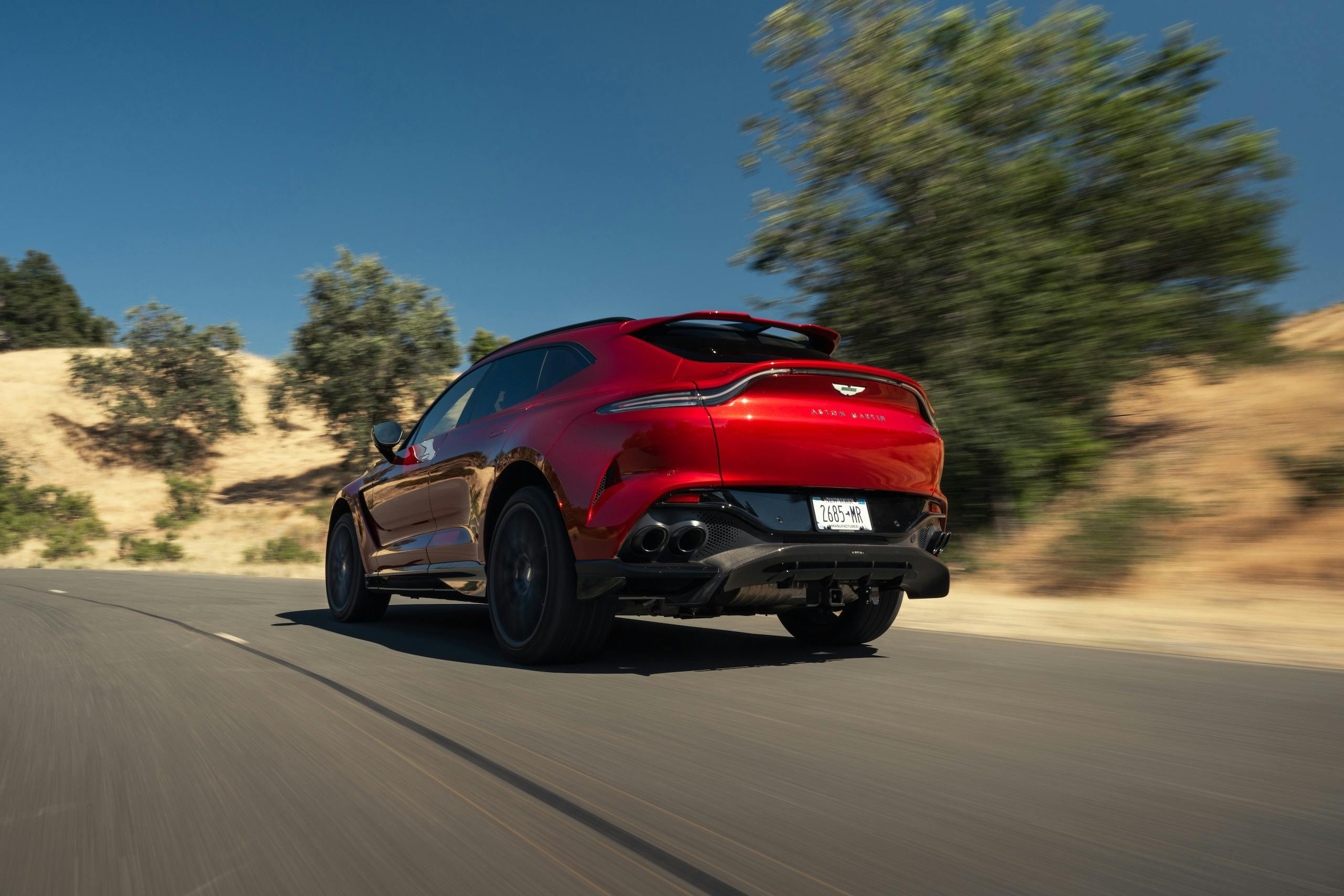
As you’d expect, the MSRP for such a vehicle is steep; Aston Martin’s super SUV starts at $249,000 (plus $3000 for destination), and options are plentiful as well as pricey. At $342,600, our tester for this review was stuffed with extras: a 23-speaker, $12,300 Bowers & Wilkins audio system, a $13,600 finish in Supernova Red courtesy of the “Q by Aston Martin” customization department, over $30,000 of carbon fiber exterior bits, including a wild rear diffuser that sat in stark contrast to the universally sized trailer hitch receiver behind it, $7200 worth of 23-inch wheels (the standard size is 22 inches), an $11,900 monotone interior in Spicy Red Semi Aniline leather. To top it off, our DBX707 also featured a $500 umbrella to keep you dry while making it rain.
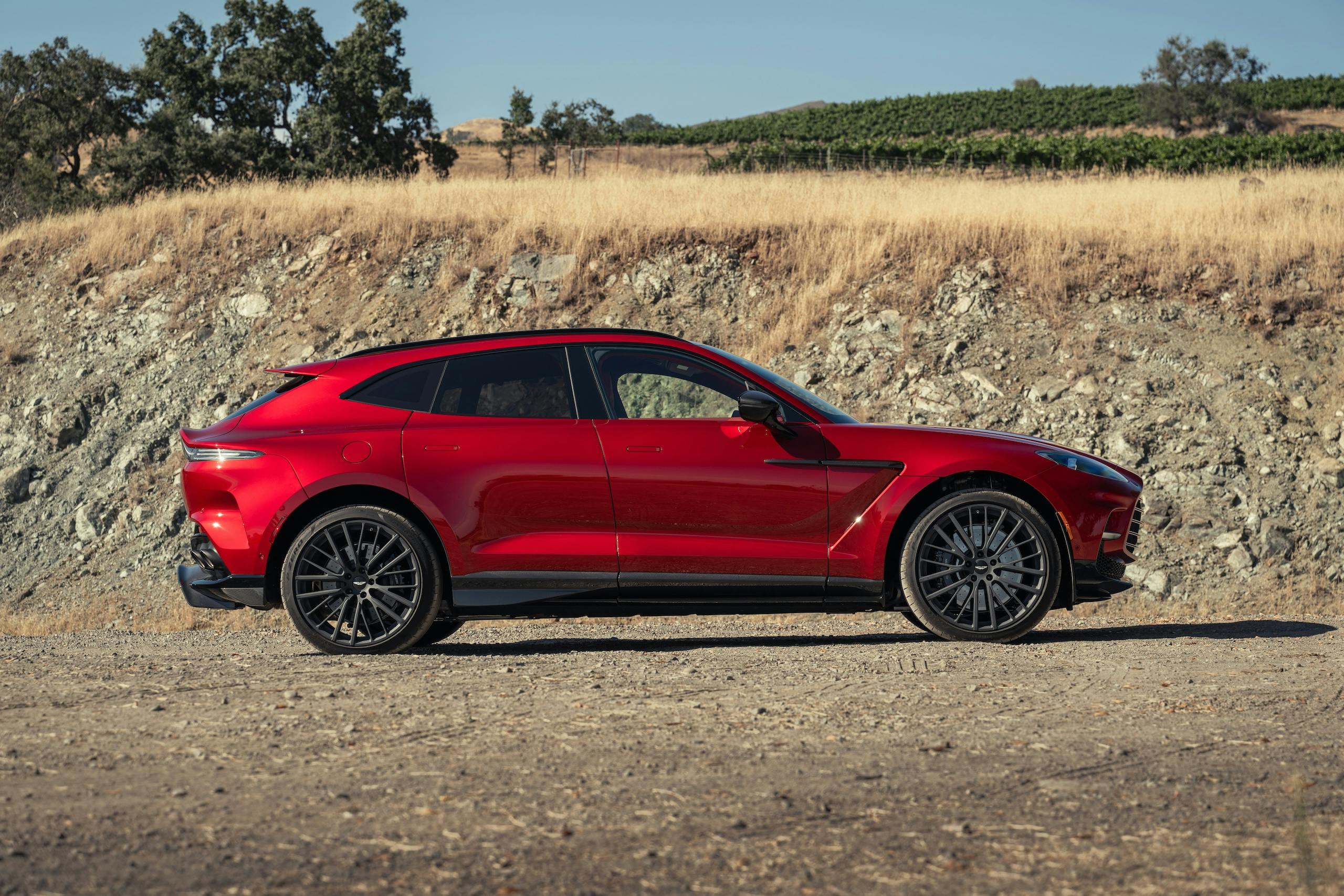

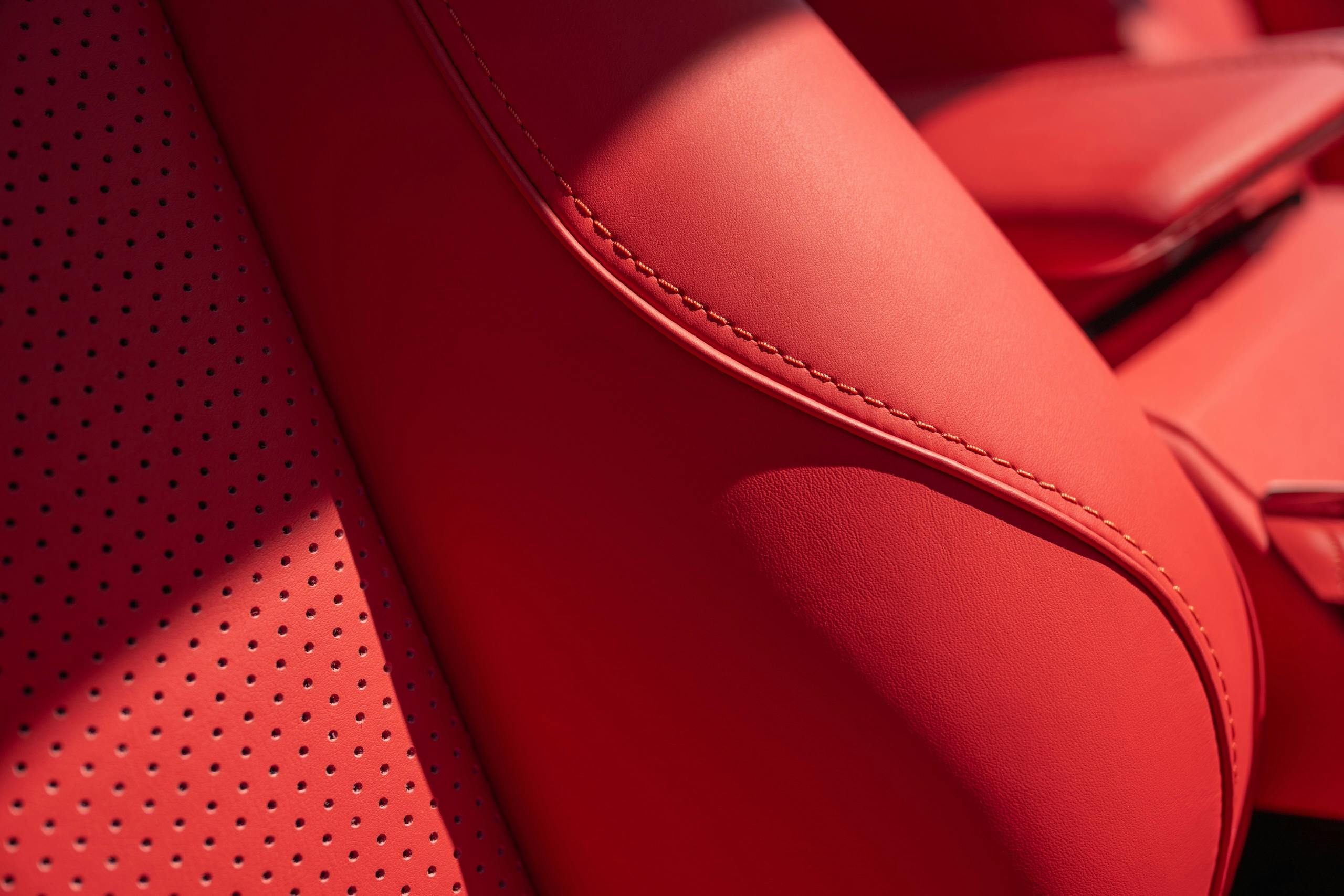
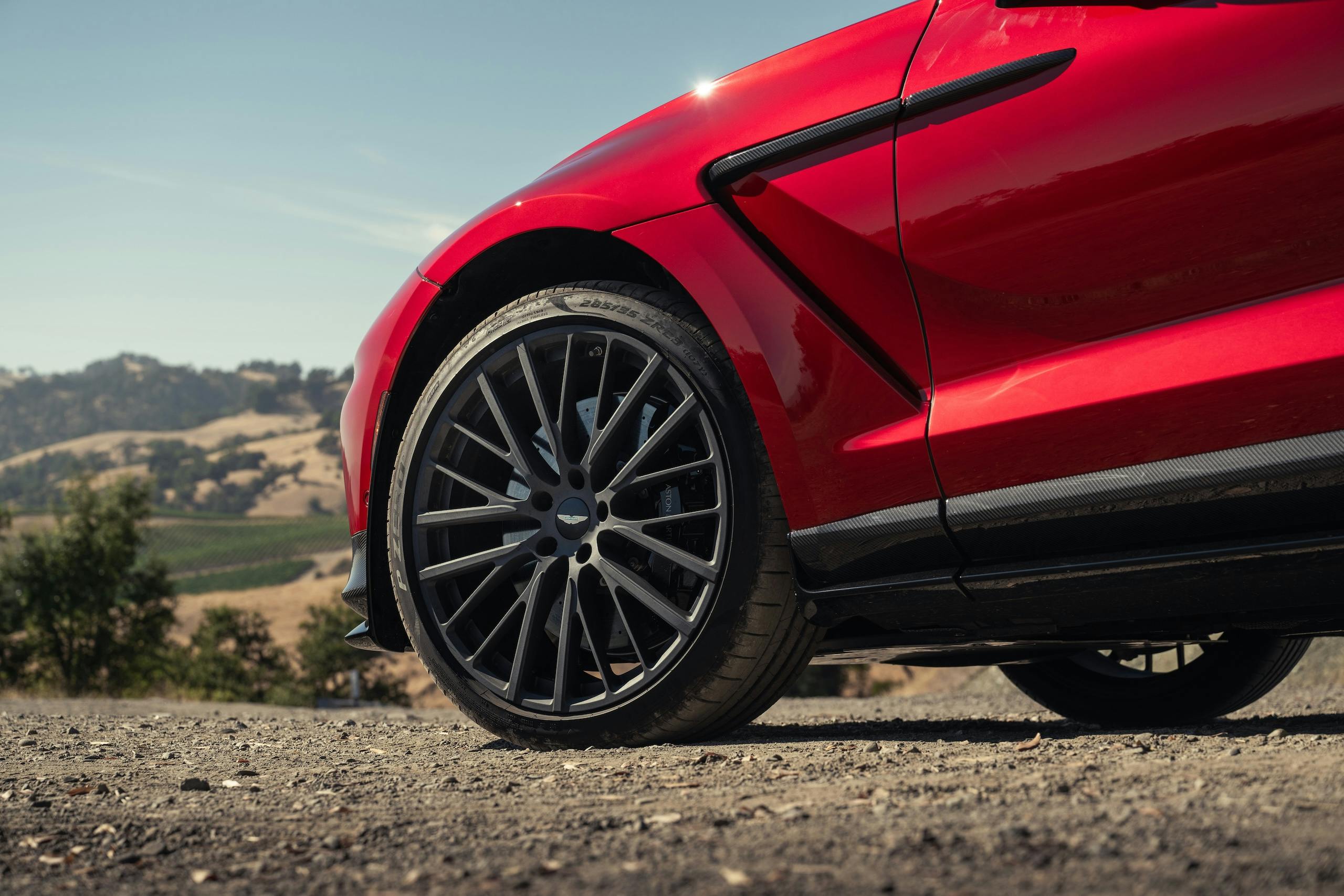
Specs: 2025 Aston Martin DBX707
- Price: $252,086 / $342,600 (base / tested)
- Powertrain: 4.0-liter twin-turbocharged V-8; nine-speed automatic transmission
- Horsepower: 697 hp @ 6000 rpm
- Torque: 664 lb-ft @ 2600–4500 rpm
- Layout: Front-engine, four-door, five-passenger, all-wheel-drive SUV
- Weight: 4940 pounds
- 0-60: 3.1 seconds
- Top Speed: 193 mph
- EPA Fuel Economy: 15/20/17 mpg (city / highway / combined)
- Competitors: Lamborghini Urus, Ferrari Purosangue, Porsche Cayenne Turbo GT, Bentley Bentayga, Rolls-Royce Cullinan
For the 2025 model year and mid-cycle refresh of the DBX, your quarter-million-dollar tribute to Gaydon goes further than before, thanks to a major interior redesign and software update. If you want the cheaper, base-model DBX, first introduced as a 2021 model, you’ll have to find leftover inventory or buy one used; Aston Martin has discontinued it in favor of the more powerful DBX707 version.
The sole powertrain for the DBX707 is the same AMG-sourced twin-turbo 4.0-liter V-8 and nine-speed wet-plate-clutch automatic transmission. This package is fundamentally unchanged since the DBX707’s debut in 2022, but seeing as the engine is good for 697 hp and 664 lb-ft of torque, its performance is, let’s say, sufficient.

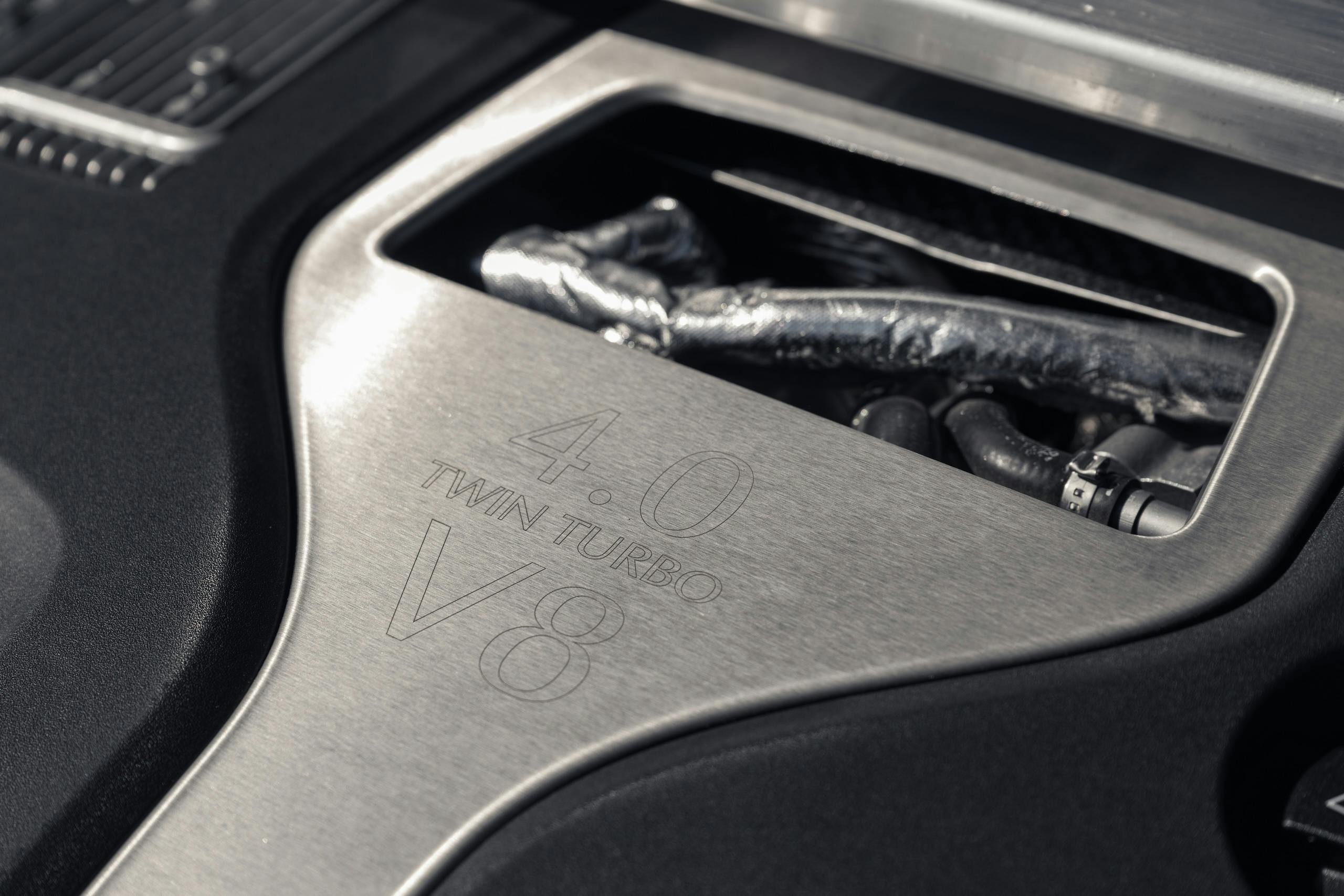
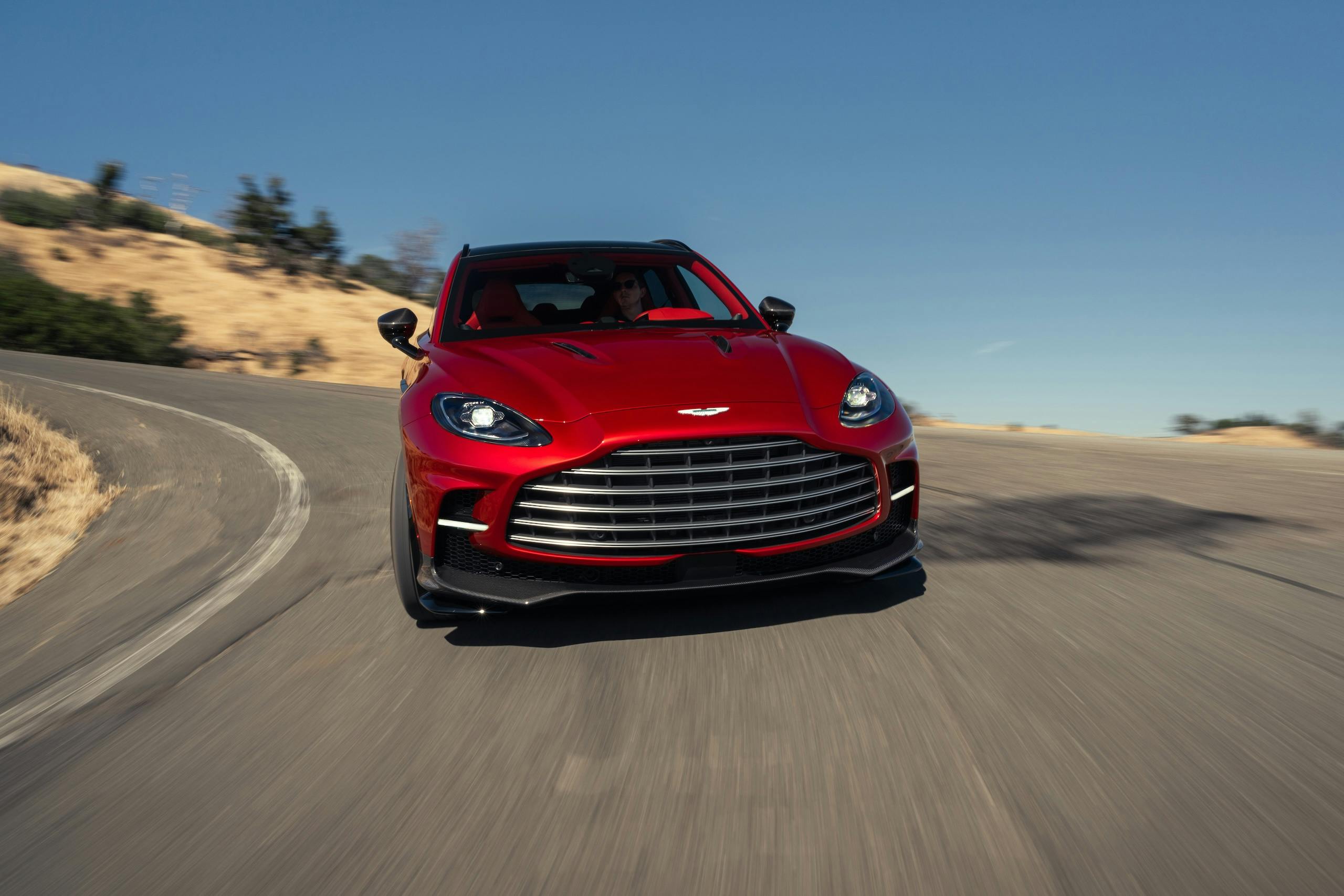
The Aston’s handling has benefited from a minor, iterative chassis update: recalibrated air springs and electronic dampers. DBX Chief Engineer Andy Tokley says this fiddling has resulted in a quicker reaction to driver inputs than before, albeit with the same character.
Before he arrived to lead the long-awaited DBX project in 2016, Tokley was an engineer at Lotus. (You can see where this is going.) Outright power and straight-line speed aren’t enough to compete with the Porsche Cayenne Turbo GT or the Lamborghini Urus, let alone the new breed of EV super-SUVs, so Tokley’s focus was to leveraging his background in suspension and chassis design to make this big Brit carve corners better than its rivals.

We’re dealing with a tall, portly sort of high performance, which means Newton’s Laws are especially burdensome for chassis engineers of super-SUVs. That’s where tech like electric active roll control (or “eARC,” which uses insanely torquey (1400Nm-capable, or 1032 lb-ft) electric motors on each axle to create a system akin to active anti-roll bars. Separate control of the suspension’s compression and rebound damping helps to hide the DBX707’s healthy 4940-pound curb weight, also allowing it to behave very differently depending on which of the drive modes the driver selects from the dial in the center console. Modes include GT, Sport, Sport+, Terrain for off-roading, and an Individual setting which allows the driver to mix and match exhaust, suspension, and powertrain settings.
What truly separates the DBX707 from its high-end competitors is the fact that it doesn’t share its bones with anything else. Remember: The Urus, Cayenne, and Bentley Bentayga share the same VW Group MLB Evo C/D modular platform. Tokley remarked on the freedom of setting the optimal seating position, suspension mounting points, wheelbase, track, and general dimensions without having to make compromises catering to a bunch of models at different price and performance points.

Appearance-wise, the DBX707 reflects its multi-tool nature. There are aerodynamic, wind-manipulating flourishes worthy of a supercar (the roof spoiler and rear diffuser in particular), but you’ll find no ostentatious edginess that characterizes so much of today’s fast fare. For example, instead of a carbon-fiber roof that would have shaved some pounds and lowered the center of gravity a skosh, the passengers are treated to an enormous expanse of glass more suited to the Aston’s lux guts. (On that note, headroom in the front and rear is more than adequate for someone like me, at a bit over six feet tall.)
The first design element that you notice from outside the DBX707 is the massive mouth, required to feed the V-8 and its voracious turbos. The shape of that maw is familiar to Aston fans and almost friendly when you look at it next to something like the Urus wears. The surfacing around the front end is more muscular and pronounced with its flared cheeks and slices of carbon fiber on the bulged hood, but that softens as you follow the upper character line across its flanks. At the rear end, aero elements flourish above and below the distinctive duckbill trunk that’s traced by the full-length taillight design. It stands out on the road, but not obnoxiously so.




Changes to the DBX707’s exterior for the 2025 model year are as follows: door handles that extend out from their flush resting position to meet you upon unlocking, a new side mirror design that rotates the entire mirror housing on a stalk rather than the glass portion alone, and a few fresh paint finish choices. New exterior colors include Epsilon Black, Helios Yellow, Sprint Green, Malachite Green, Aura Green, or Podium Green which was previously only available on the DBX707 AMR23 Edition. Also new for 2025 are two new wheel finishes: Satin Black on the 23-inch Fortis wheel option and Copper Bronze on the 23-inch Forged wheel option. Design of the 22-inch Sport, 23-inch Fortis, and 23-inch Forged wheels is the same as before, and you can still spec those with either Silver, Gloss Black, Textured Black, Satin Black, or Satin Black Diamond Turned finishes.

Whereas prior DBX models used older versions of Mercedes-Benz infotainment inside—to underwhelming effect for a prestige brand such as Aston Martin—the 2025 DBX707 brings with a new in-house system. The setup adds wireless Apple CarPlay and Android Auto, as well as a proper touchscreen —a 10.25-inch infotainment display that sits above the center console and is complemented by the 12.3-inch digital dashboard. Additional changes include larger door panel veneers with more materials to choose from, redesigned interior door handles, vertical HVAC vents, a new flat-bottom steering wheel, and an array of physical controls—including some haptic bliss in the form of roller dials to manipulate the HVAC and sound system. It all surrounds a new centrally located gear selector, which replaces the old, frankly odd system that had drivers using a series of buttons mounted high on the dash to change from park to drive to reverse.
The changes are all positive, and the software is all easy and generally intuitive to navigate, although there was a bit of lag when using the dedicated drive mode knob. And it would be nice to have a larger gear indicator on the dash; perhaps the current gear could be displayed in the middle of the tach in place of the big Aston Martin logo, at least in sportier drive modes when you don’t want to squint. My only other gripe is that the icons on the new touchscreen are a bit small and easy to fat-finger while on the move. That $12K Bowers & Wilkins system is excellent, however, as it should be at that price point.






What about the drive? Well, if you’ve read this far you probably know what comes next: This is a phenomenally fast flouter of physics. Put it in GT mode and waft over undulating roads at 120+ mph before slowing down and crawling around town, where it’s free of over-eager throttle response or a brutal suspension profile.
The real fun, of course, is driving this SUV like it isn’t one. The route that Aston Martin laid out for our test day was a sublime mixture of extended sweepers and Miata-grade serpentines. (To be honest, it would have been a ton of fun in a Chevy Astro.) In Sport+ mode, the transmission was nearly always in the right gear, but the nine-speed’s programming is happy to let the revs hang near redline when the paddles are in use. I stopped playing around with the “manual” paddle shifting mode after a few corners, as they weren’t much better than full automatic. Grip was immense thanks in part to the 280-treadwear Pirellis, but more so because of the suspension’s active setup. When pushing hard, I could feel the character of the chassis changing around me as the active dampers and anti-roll mechanisms did their respective duties, but the feedback was such that I never felt like a passenger instead of a driver.
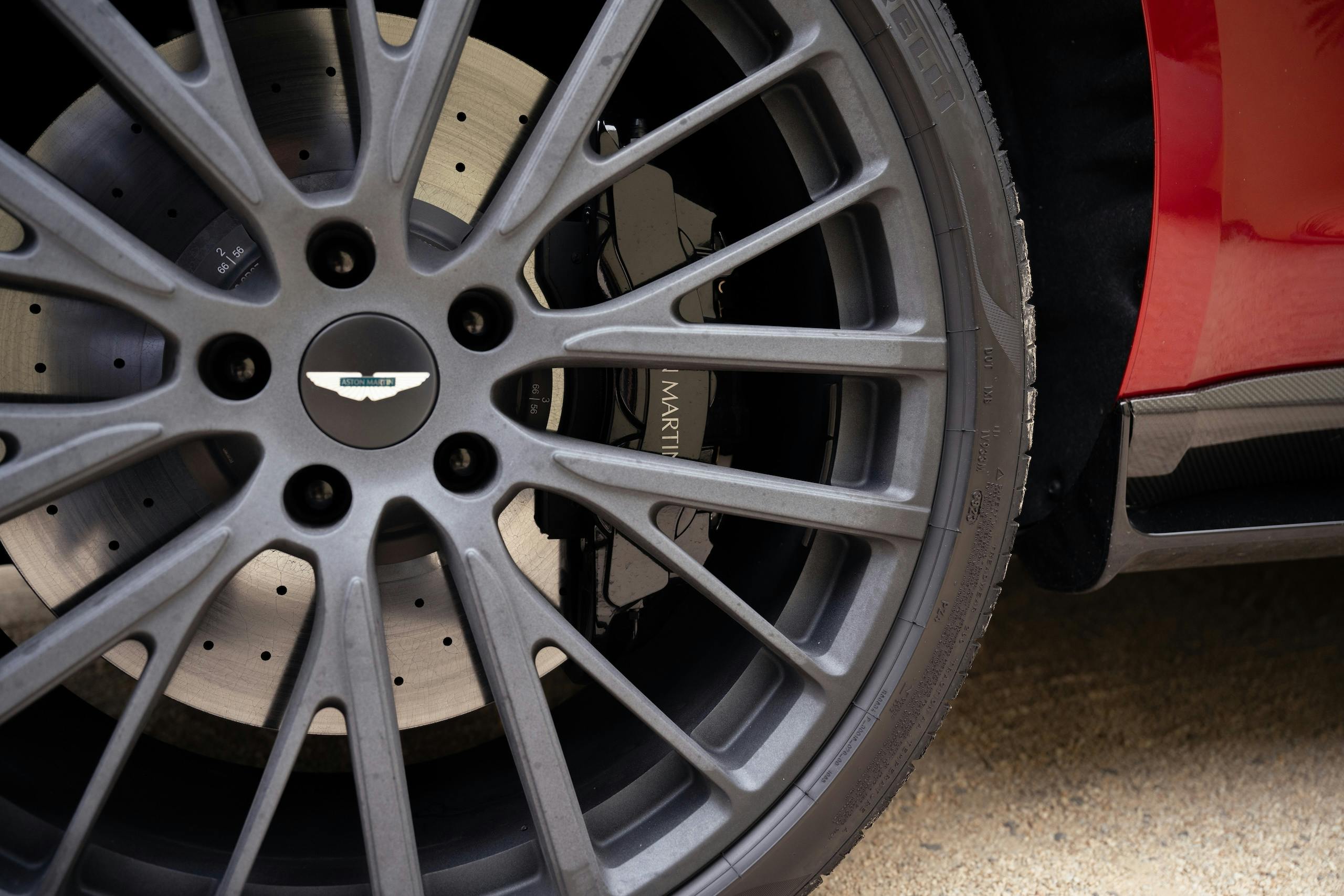
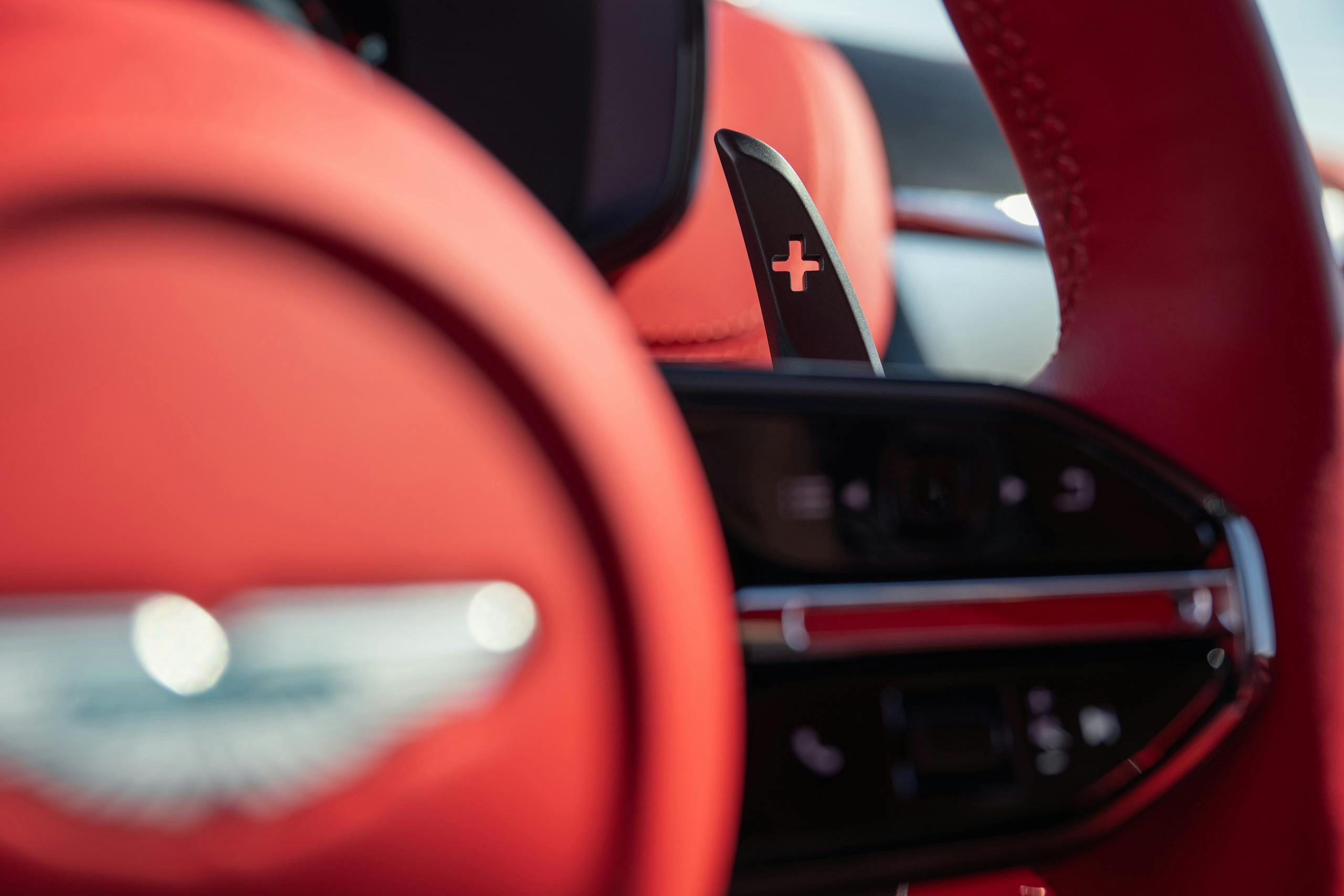

All that said, you are often reminded that this is a DBX and not a DB12 or Vantage. It goes where you point it, sure, but there is also characteristically long suspension travel. You feel the car’s mass shifting amid sudden inputs, but these sensations are transmitted to the driver in a way that makes you even more impressed with what the 707 can do. Coming out of a tight second-gear corner with the tach about two thirds of the way through its sweep was a riot, and the huge carbon-ceramic brakes (16.5-inch rotors with six-piston calipers up front, and 15.3-inchers with sliding-piston calipers in the back) gave me enough confidence to take full advantage of the torquey powerband on even the shortest straight sections between bends.
The 2025 Aston Martin DBX707 is about as good as all-in-one personal vehicles get. There are faster cars and more capable SUVs, but a very short list of direct competitors to this amalgamation of speed, style, and serenity. Scoff all you want at its price tag and its purpose, but you’d better drive one before dismissing it as totally silly. (It is a little silly.) The Aston Martin brand is about elegance and performance, and if an SUV trimmed in a herd’s worth of leather can still 193 mph while bumping a 16,000-watt sound system, it deserves some respect.
2025 Aston Martin DBX707:
Price: $252,086 / $342,600 (base / tested)
Highs: Supercar performance in a practical package. Much-improved interior and infotainment with this refresh.
Lows: Option costs add up rapidly. Despite the great engine, its AMG origin does not speak to Aston heritage.
Summary: Minor chassis tweaks and a noticeably more thoughtful cabin make the DBX a whole lot more worth consideration, if you have the scratch.































